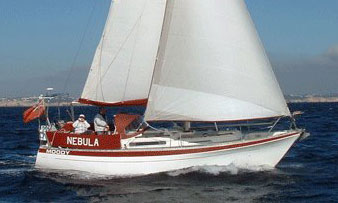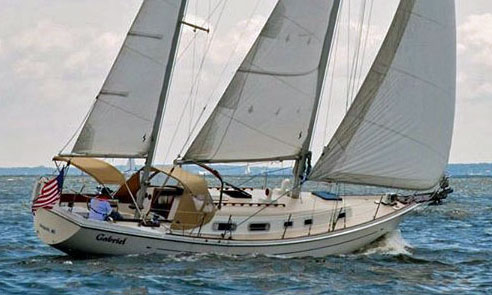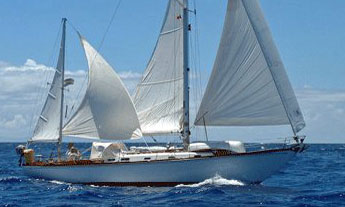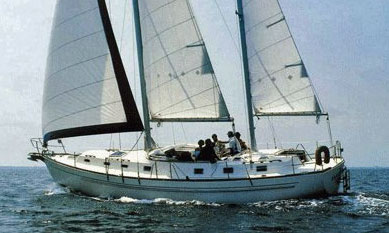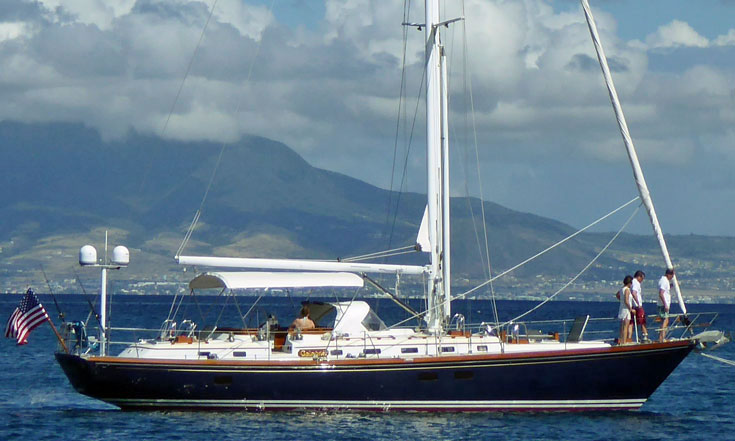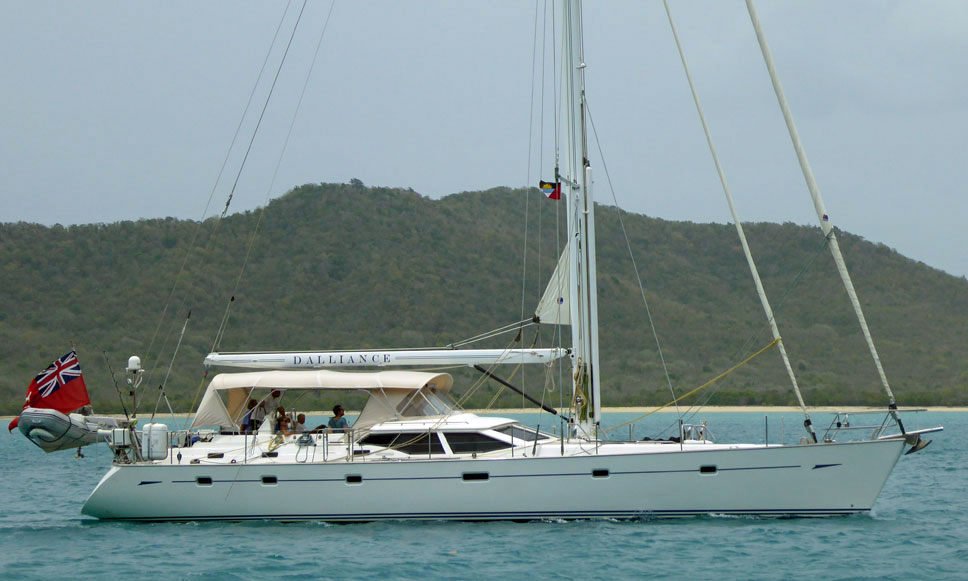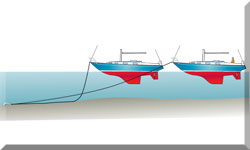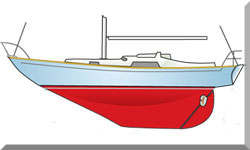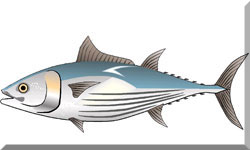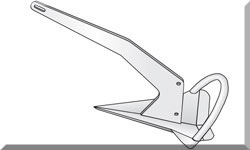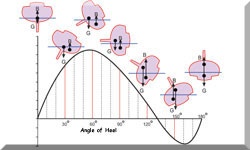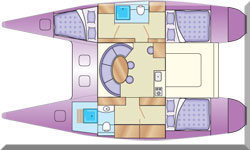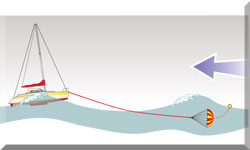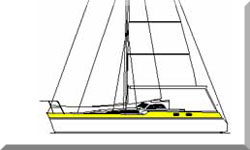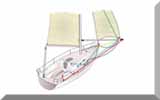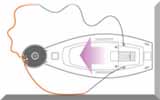- Home
- Cruising Yachts 45' to 50'
- Hunter 466 Sailboat
The Hunter 466 Sailboat
Specs & Key Performance Indicators
The Hunter 466 sailboat was designed by the Hunter Design Team and manufactured by Hunter Marine in the United States throughout the years 2002 to 2005.
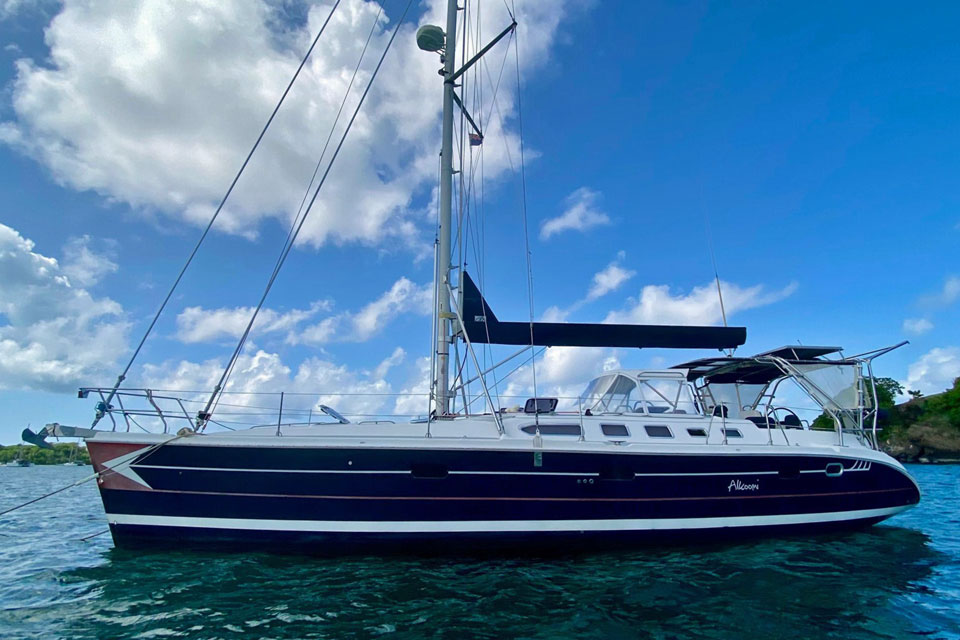 A Hunter 466 at anchor
A Hunter 466 at anchorPublished Specification for the Hunter 466
Keel & Rudder Configuration: Fin keel and spade rudder.
Hull Material: Fiberglass.
Length Overall: 46'1" (14.1m)*.
Waterline Length: 39'8" (12.1m)*.
Beam: 14'0" (4.3m)*.
Draft: 6'6" (2m).
Rig Type: Sloop with B&R rigging.
Displacement: 26,180 lbs (11,875 kg)*.
Ballast: 9,680 lbs (4,391 kg)*.
Sail Area: 933ft2 (86.7m²)*.
Water Tank Capacity: 200 US gallons (757 litres).
Fuel Tank Capacity: 100 US gallons (379 litres).
Hull Speed: 8.44 knots.
Designer: Hunter Design Team.
Builder: Hunter Marine.
Year First Built: 2002.
Year Last Built: 2005.
Number Built: Information not available.
* Used to derive the design ratios referred to later in this article - here's how they're calculated...
Options & Alternatives
- Keel Options: Buyers could choose between a standard fin keel and an optional shoal draft wing keel. The wing keel version had a reduced draft of 5'6" (1.68 m).
- Interior Layouts: The Hunter 466 offered flexibility in interior configurations, including two or three stateroom layouts. These layouts catered to different needs, from maximizing living space to providing additional storage.
- Factory Options: Additional features included in-mast furling mainsails, spinnaker setups, air conditioning, leather cushions, and even a water-maker for extended cruising.
While no direct later versions of the Hunter 466 were produced, Hunter Marine offered other models in the same size range, such as the Hunter 460 and Hunter 456, with unique features and configurations.
Sail Areas & Rig Dimensions
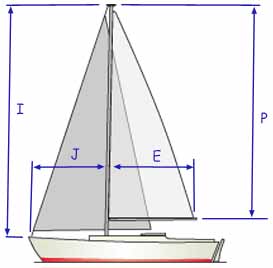 Sail Areas & Rig Dimensions
Sail Areas & Rig DimensionsSail Areas:
- Mainsail Area: Approximately 463ft2 (43m²).
- Foresail Area: Approximately 470ft2 (43.7m²).
Rig Dimensions:
- I: 55'5" (16.9m)
- J: 17'1" (5.2m)
- P: 51'6" (15.7m)
- E: 18'0" (5.5m)
Published Design Ratios
The Key Performance Indicators (KPIs)
The design ratios of the Hunter 466 sailboat provide valuable insight into its theoretical sailing characteristics:
- Sail Area/Displacement Ratio (17.0): This suggests the Hunter 466 strikes a good balance between power and ease of handling. It is capable of maintaining decent speed even in lighter winds, making it suitable for cruising with efficient sail plans.
- Ballast/Displacement Ratio (37.0): With this ratio, the sailboat demonstrates a strong level of stability and resistance to heeling under sail. It's a reliable choice for comfortable cruising, especially in moderate conditions.
- Displacement/Length Ratio (187): Falling in the light displacement category, the Hunter 466 promises good agility and responsiveness. It may not excel in heavy-weather conditions but performs well in more temperate climates and lighter breezes.
- Comfort Ratio (29.0): This indicates the Hunter 466 is optimized for coastal cruising, offering sufficient comfort for extended trips but not ideal for extreme ocean voyages.
- Capsize Screening Formula (1.9): With a value below 2.0, the boat is considered seaworthy for bluewater cruising, with reduced risk of capsize in challenging conditions.
Overall, these ratios suggest the Hunter 466 is a versatile cruiser that blends stability, comfort, and agility, making it a solid choice for coastal cruising and occasional bluewater adventures.
But the Design Ratios are Not the Whole Story...
While design ratios are helpful for understanding some aspects of a sailboat's performance, they come with limitations:
- Simplistic Estimates: Ratios like Sail Area/Displacement or Ballast/Displacement provide rough guidelines, but they oversimplify the complex interplay of factors like hull shape, sail design, and weight distribution.
- Context-Specific Validity: These ratios don’t account for sailing conditions. For example, a high Sail Area/Displacement ratio might suggest good performance in light air, but it doesn't guarantee stability in stronger winds.
- Omission of Modern Technologies: Advanced materials, rigging designs, and other technological improvements can significantly alter a boat's characteristics, which design ratios typically don't reflect.
- Individual Preferences: Comfort and performance are subjective; one sailor might value stability, while another prioritizes speed. Ratios can't fully predict how a sailboat will feel to an individual under sail.
- Lack of Detailed Analysis: Ratios ignore critical performance elements like upwind efficiency, downwind performance, or handling under reefed sails.
In short, while design ratios are a starting point, they must be supplemented with hands-on experience, detailed design analysis, and performance data to truly understand a sailboat’s sailing characteristics.
More Specs & Key Performance Indicators for Popular Cruising Boats
This article was written with the assistance of Gemini, a large language model developed by Google. Gemini was used to gather information, summarize research findings, and provide suggestions for the content and structure of the article.
Recent Articles
-
Optimising Your 12-Volt Boat Fridge for Offshore Sailing & Efficiency
Dec 01, 25 11:05 AM
Master your 12-Volt Boat Fridge system. A guide for experienced sailors covering mechanics, installation, troubleshooting, and advanced electrical efficiency on extended voyages. -
Jonmeri 40: Cruising Specs, Performance Ratios & Review
Nov 30, 25 09:08 AM
An in-depth, expert review of the Jonmeri 40 sailboat. Analyse design philosophy, D/L & CSF ratios, cruising suitability, and common ownership concerns for this Finnish-built, high-performance ocean c… -
Alajuela 48: Review, Specs, & Performance Ratios for Offshore Cruisers
Nov 29, 25 12:46 PM
Detailed analysis of the Alajuela 48 full-keel cruiser, including designer Robert Perry's philosophy, comprehensive specifications, key design ratios (SA/D, D/L, CSF), and suitability for experienced…

